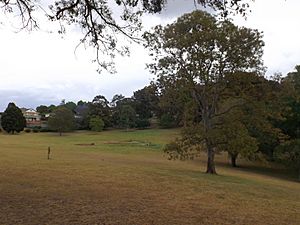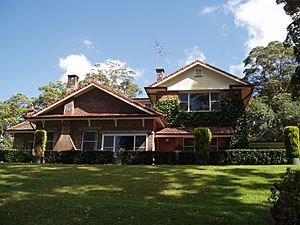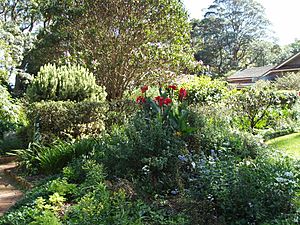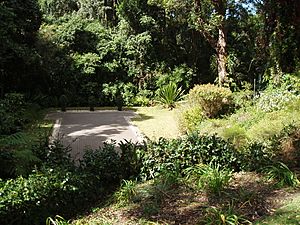Boyce Gardens facts for kids
Quick facts for kids Boyce Gardens |
|
|---|---|

Grassed area, 2014
|
|
| Location | 6 Range Street, Mount Lofty, Toowoomba, Toowoomba Region, Queensland, Australia |
| Design period | 1919 - 1930s (interwar period) |
| Built | c. 1930 - 1950s |
| Official name: Boyce Gardens | |
| Type | state heritage (built, landscape) |
| Designated | 25 January 2001 |
| Reference no. | 601311 |
| Significant period | 1930-1950s (fabric) 1930-1969 (historical) |
| Significant components | garden/grounds, tennis court, trees - remnant scrub, trees/plantings, tank - reservoir, plaque, garden - ornamental/flower, terracing, mill - wind, wall/s - garden, orchard, residential accommodation - housing, swimming pool |
| Lua error in Module:Location_map at line 420: attempt to index field 'wikibase' (a nil value). | |
Boyce Gardens is a special heritage-listed garden and citrus farm. You can find it at 6 Range Street, Mount Lofty, in Toowoomba, Queensland, Australia. This amazing place was built between the 1930s and 1950s. It was added to the Queensland Heritage Register on January 25, 2001, because of its important history and beauty.
The Story of Boyce Gardens
Boyce Gardens is named after Leslie and Margaret Boyce. They started this garden after they got married in April 1930 and moved to Toowoomba. Over the years, they added more to their home in 1940 and 1955. They built a tennis court in 1937 and a swimming pool in 1947.
Starting the Garden
In 1929, Margaret Hall bought six hectares of land. This land was on the edge of Toowoomba. It had a eucalyptus forest, a natural rainforest, and an old dairy farm. Margaret and Leslie Boyce moved into their new house after their wedding in 1930. They spent the rest of their lives living and gardening there. After they passed away, their ashes were scattered in the garden they loved so much.
Bringing the Rainforest Back to Life
When the Boyces first bought the land, much of the natural rainforest was overgrown. It had many unwanted plants like lantana and camphor laurel. The Boyces loved visiting rainforests in Queensland. They decided to "restore, regenerate, and preserve" the rainforest on their property.
They carefully removed the unwanted plants. They wanted to bring back the native trees and plants. They even set up a special watering system to help the new plants grow. Today, the rainforest canopy is over thirty metres high! They also introduced about fifteen new native plant species to the area.
Creating Beautiful Gardens
The Boyces spent a lot of time working on their gardens. They created many different areas, like a sunken garden, a terraced flower garden, and a walled garden. Margaret Boyce loved trying out new plants. She kept excellent records of what grew well in Toowoomba. This information was very helpful for other gardeners in the city.
Toowoomba is known as the "Garden City." This is partly because of the annual Toowoomba Carnival of Flowers. The Boyces' garden has even been part of the Exhibition Gardens program. This program shows off beautiful private gardens during the Carnival.
The Boyces also traveled the world to learn about plants. They visited many famous gardens. They brought back ideas and plants from their trips. For example, they planted South African proteas after a trip to Africa.
Giving the Gardens to the Public
In 1969, the Boyces gave their estate to the University of Queensland. They wanted the land to be used for education. They also wanted the gardens and forest to be kept safe for the public to enjoy. Leslie Boyce even received an honorary degree from the university for his work. The Boyces continued to look after the property until they died. They also set up a fund to help maintain the gardens forever.
Today, the goal is to keep developing the gardens. They want it to be a beautiful place for everyone to visit. It is also an important tourist attraction in Toowoomba.
What You Can See at Boyce Gardens
Boyce Gardens has many different parts to explore. These include the rainforest, a pine forest, and an avocado orchard. There are also special garden areas with collections of different flowers. You can find a walled garden, a tennis court, and a swimming pool. The house itself is also part of the property.
The garden uses the natural slopes of the land very well. The house sits on a high point, giving great views of the garden. The garden is hidden from Range Street by thick plants. As you enter the driveway, you can see the water tank and windmill. These are important for keeping the garden alive.
The Rainforest
The rainforest is in the north-east corner of the property. It is full of native trees, shrubs, and ferns. You can see different types of fig trees, Hoop Pines, and Silky Oaks. There are also many kinds of ferns, like Birds Nest Ferns.
Avocado Orchard
On a part of the property that slopes east, you'll find many avocado trees. These trees were planted in 1952, so they are almost fifty years old! There are also some citrus trees in this area.
White Garden
The White Garden is a circular sunken area. It is located north of the main property. This garden has climbing plants, tree ferns, and camellias. You can also see the Rose Bed nearby.
The House
The house is a two-story brick building with a brick courtyard. It has been made bigger over time. But it still has many original features. These include wooden wall panels and decorative ceilings. The inside staircase also has its original fancy ironwork. Some rooms have original cedar wood details.
Walled Garden
Behind the house, to the south, you'll find the terraced cut flower area and the walled garden. This area has a wavy brick wall. To the west is the compost area and the old vegetable garden. Along the western side, there's a mixed border with many different plants. These include hibiscus, peaches, cherries, and lavender.
Tennis Court and Swimming Pool
The tennis court is now covered in grass. It is surrounded by netting. On one side, there are two rows of Jacaranda trees. These trees separate the tennis court from the avocado orchard. Near the tennis court, you'll find the swimming pool. There are plaques here that remember Dr. and Mrs. Boyce.
There is a walking track through the Gardens. You can choose an easier, flatter path. Or you can take a steeper route. This path goes through the rainforest, the pine forest, and up to the avocado orchard. From the open park area, you can see views towards Jellicoe Street.
Why Boyce Gardens is Special
Boyce Gardens is listed on the Queensland Heritage Register for many reasons.
A Look into History
This garden shows how people experimented with bringing native plants back to an area. It's also a great example of a 1930s home with its original garden. Boyce Gardens is very important to Toowoomba, which is famous for its beautiful gardens. It also helps us understand the history of gardening in Queensland. This is because of its design and the detailed records kept by the Boyces.
Rare and Unique
Boyce Gardens has a rare and healthy piece of rainforest. This includes a 150-year-old strangler fig tree. This makes the garden very special and adds to the beauty of the area.
Beautiful and Important
The garden is known for its beauty. It has a strong visual impact from the street. It is also important for science. It's a well-documented example of a regenerated rainforest. Over 100 types of trees and shrubs have been found here. The Australian Garden History Society says Boyce Gardens is very important to Queensland's garden history.
Connected to the Community
Boyce Gardens is important because of its connection to Leslie and Margaret Boyce. They were well-known people in Toowoomba for over fifty years. The garden has also been enjoyed by many visitors over the years.




